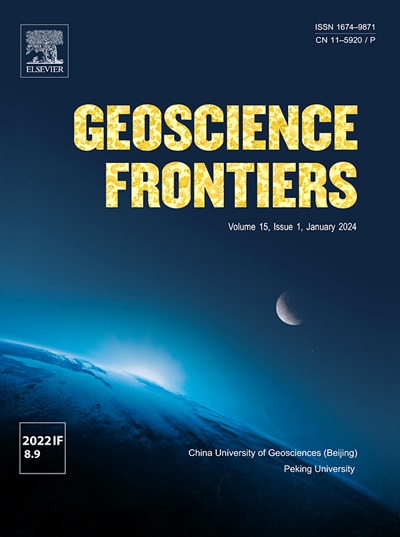Assessing the groundwater recharge processes in intensively irrigated regions: An approach combining isotope hydrology and machine learning
IF 8.9
1区 地球科学
Q1 GEOSCIENCES, MULTIDISCIPLINARY
引用次数: 0
Abstract
Agriculture is a major contributor to the global economy, accounting for approximately 70% of the freshwater use, which cause significant stress on aquifers in intensively irrigated regions. This stress often leads to the decline in both the quantity and quality of groundwater resources. This study is focused on an intensively irrigated region of Northern India to investigate the sources and mechanism of groundwater recharge using a novel integrated approach combining isotope hydrology, Artificial Neural Network (ANN), and hydrogeochemical models. The study identifies several key sources of groundwater recharge, including natural precipitation, river infiltration, Irrigation Return Flow (IRF), and recharge from canals. Some groundwater samples exhibit mixing from various sources. Groundwater recharge from IRF is found to be isotopically enriched due to evaporation and characterized by high Cl−. Stable isotope modeling of evaporative enrichment in irrigated water helped to differentiate the IRF during various cultivation periods (Kharif and Rabi) and deduce the climatic conditions prevailed during the time of recharge. The model quantified that 29% of the irrigated water is lost due to evaporation during the Kharif period and 20% during the Rabi period, reflecting the seasonal variations in IRF contribution to the groundwater. The ANN model, trained with isotope hydrogeochemical data, effectively captures the complex interrelationships between various recharge sources, providing a robust framework for understanding the groundwater dynamics in the study area. A conceptual model was developed to visualize the spatial and temporal distribution of recharge sources, highlighting how seasonal irrigation practices influence the groundwater. The integration of isotope hydrology with ANN methodologies proved to be effective in elucidating the multiple sources and processes of groundwater recharge, offering insights into the sustainability of aquifer systems in intensively irrigated regions. These findings are critical for developing data-driven groundwater management strategies that can adapt to future challenges, including climate change, shifting land use patterns, and evolving agricultural demands. The results have significant implications for policymakers and water resource managers seeking to ensure sustainable groundwater use in water-scarce regions.

密集灌区地下水补给过程评估:同位素水文学与机器学习相结合的方法
农业是全球经济的主要贡献者,约占淡水使用量的70%,这对集约灌溉地区的含水层造成了重大压力。这种压力往往导致地下水资源的数量和质量下降。本研究以印度北部集约化灌区为研究对象,采用同位素水文学、人工神经网络(ANN)和水文地球化学模型相结合的新型综合方法,研究了地下水补给的来源和机制。该研究确定了地下水补给的几个关键来源,包括自然降水、河流入渗、灌溉回流(IRF)和运河补给。一些地下水样品显示出来自不同来源的混合。IRF补给的地下水因蒸发作用而同位素富集,具有高Cl−的特征。灌溉水蒸发富集的稳定同位素模型有助于区分不同耕作时期(Kharif和Rabi)的IRF,并推断补给时期的气候条件。该模型量化了29%的灌溉水在Kharif期和20%的Rabi期因蒸发而损失,反映了IRF对地下水贡献的季节性变化。利用同位素水文地球化学数据训练的人工神经网络模型,有效地捕捉了各种补给源之间复杂的相互关系,为了解研究区地下水动态提供了一个强大的框架。开发了一个概念性模型来可视化补给源的时空分布,强调季节性灌溉做法如何影响地下水。同位素水文学与人工神经网络方法的结合被证明在阐明地下水补给的多种来源和过程方面是有效的,为深入了解集约灌区含水层系统的可持续性提供了见解。这些发现对于制定数据驱动的地下水管理战略至关重要,这些战略可以适应未来的挑战,包括气候变化、土地利用模式的转变和不断变化的农业需求。研究结果对寻求确保缺水地区地下水可持续利用的政策制定者和水资源管理者具有重要意义。
本文章由计算机程序翻译,如有差异,请以英文原文为准。
求助全文
约1分钟内获得全文
求助全文
来源期刊

Geoscience frontiers
Earth and Planetary Sciences-General Earth and Planetary Sciences
CiteScore
17.80
自引率
3.40%
发文量
147
审稿时长
35 days
期刊介绍:
Geoscience Frontiers (GSF) is the Journal of China University of Geosciences (Beijing) and Peking University. It publishes peer-reviewed research articles and reviews in interdisciplinary fields of Earth and Planetary Sciences. GSF covers various research areas including petrology and geochemistry, lithospheric architecture and mantle dynamics, global tectonics, economic geology and fuel exploration, geophysics, stratigraphy and paleontology, environmental and engineering geology, astrogeology, and the nexus of resources-energy-emissions-climate under Sustainable Development Goals. The journal aims to bridge innovative, provocative, and challenging concepts and models in these fields, providing insights on correlations and evolution.
 求助内容:
求助内容: 应助结果提醒方式:
应助结果提醒方式:


